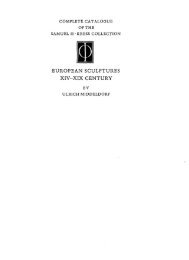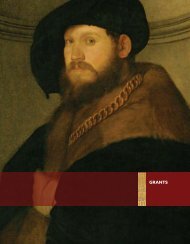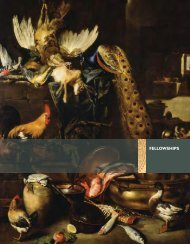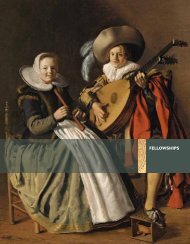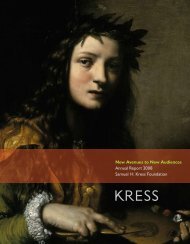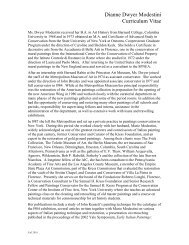The Campus Art Museum - Samuel H. Kress Foundation
The Campus Art Museum - Samuel H. Kress Foundation
The Campus Art Museum - Samuel H. Kress Foundation
You also want an ePaper? Increase the reach of your titles
YUMPU automatically turns print PDFs into web optimized ePapers that Google loves.
<strong>Art</strong> Across the Curriculum<br />
[O]rigins of the term museum lay in the ancient Greek word for the abode of<br />
the muses, or the nine sisters who were the offspring of Zeus and Mnemosyne<br />
(memory). As the children of Memory, the muses are closely associated with<br />
the act of thinking and remembering, essential aspects in the process of<br />
learning and creativity. (Lowry 2004, 139)<br />
“<strong>Art</strong> museums in general are looking to education... education programs are<br />
growing,” stated an academic curator. She identified two probable reasons: As art<br />
programs are slashed in public schools, art museums try to ensure that children<br />
still receive some exposure to art; and academic art museums increasingly seek<br />
greater participation in the curriculum on their own campuses. <strong>The</strong> museums in<br />
this study 1 are indeed working with public schools and also engaging in innovative<br />
ways with the academic life of their institutions. This report focuses on academic<br />
involvement—on the acts of experiencing and learning, thinking and creativity—<br />
enabled by campus art museums. It is divided into seven sections: Attracting<br />
Faculty to the <strong>Campus</strong> <strong>Art</strong> <strong>Museum</strong>; Meeting Course Objectives through the <strong>Art</strong><br />
<strong>Museum</strong>; Collaborations among <strong>Museum</strong> Staff and Faculty; <strong>Museum</strong> Exhibitions<br />
and their Integration into Classes and Research; <strong>Foundation</strong> Support for Academic<br />
Integration of <strong>Art</strong> across the Curriculum; A Town/Gown Divide?; and <strong>The</strong> Power of<br />
the Original.<br />
Efforts by campus art museums to integrate art into the curriculum of<br />
colleges and universities are somewhat new. Before the 1940s, art history or fine<br />
arts departments often had resource centers that housed art collections, including<br />
photo collections and slide libraries. <strong>The</strong>se collections were primarily for use<br />
by arts faculty in research and teaching (Bradley 2009, 1). <strong>The</strong> era following the<br />
1940s saw a drastic rise in the number of art museums on campuses, with an<br />
emphasis placed on acquiring valuable collections. <strong>The</strong>se museums also began<br />
expanding their missions to serve K-12 students in public schools, becoming “the<br />
community museum on a college campus” (Bradley 2009, 1). By reaching out into<br />
the community, museums obtained both community support and funds.<br />
Education as a mission of the museum received a boost during the turbulent<br />
1960s when public and private funding sources began demanding that museums<br />
attend to their role in promoting social consciousness (Williams 2007). <strong>Campus</strong><br />
museums became even more community-focused, adopted professional standards<br />
and practices, and sought to separate themselves from departmental politics,<br />
becoming somewhat autonomous units on campus. <strong>The</strong> Tax Reform Act of<br />
1. Data for this document come from the Allen Memorial <strong>Art</strong> <strong>Museum</strong> at Oberlin College; Indiana University <strong>Art</strong><br />
<strong>Museum</strong>; Snite <strong>Museum</strong> of <strong>Art</strong> at Notre Dame University; David and Alfred Smart <strong>Museum</strong> at University of Chicago;<br />
the University of Arizona <strong>Museum</strong> of <strong>Art</strong>; the Spencer <strong>Museum</strong> of <strong>Art</strong> at the University of Kansas; and the University of<br />
Missouri <strong>Museum</strong> of <strong>Art</strong> and Archaeology. <strong>The</strong> site selection process involved “extreme case” sampling in that campus<br />
art museums that had received <strong>Kress</strong> Collections (twenty-three) were asked to self-identify as exemplary of what<br />
campus art museums at their best could be, and to submit evidence if interested in participating in the study. With the<br />
resulting pool, maximum variation sampling was used to select cases that varied widely on indicators such as private/<br />
public institutions, large/small campus populations, rural/urban locations, and recipient or not of the Mellon <strong>Foundation</strong>’s<br />
College and University <strong>Art</strong> <strong>Museum</strong> Program multi-year grants.<br />
<strong>Art</strong> Across the Curriculum<br />
4



